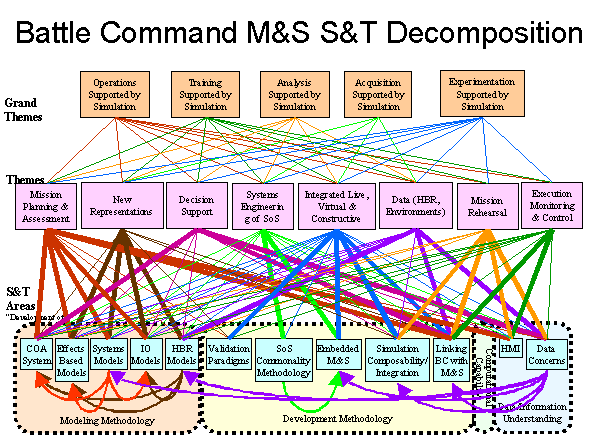| Project Metadata | Keywords | ||||||||||||||||||||||||||||||||||||||||||||
|
|
The study in question is being performed for COL George Stone, Director, Battle Command, Simulation, and Experimentation (BCSE), G3/7. A study team has been assembled (consisting of Stuart Starr, Dean Hartley, Al Sciarretta, and Mark Youngren) and asked to develop a road map for Battle Command (BC)-related M&S Science & Technology (S&T).
The existence of numerous interested parties, stakeholders, and their various effects on the formal (and informal) process of implementing S&T affected the nature of the project.
|
|
To create the road map, the team began with the findings of TRADOC's Current-to-Future Task Force. That activity identified operational gaps and technology shortfalls for the Army. Those results were analyzed to identify the technology shortfalls that were germane to BC and M&S. In addition, the team augmented those technology shortfalls based on the visionary analyses of other organizations (e.g., Office of Naval Research, views of senior Army leadership).
Ultimately this gave rise to a set of BC-related M&S S&T themes and options in four areas: modeling methodology (e.g., how do you model Information Operations?); development methodology (e.g., how do you compose models?); communications and computer support to M&S; and data and information.
To this, the team added the dimensions that described the uses to which the M&S would be put: the Army functions that would need various types of M&S (Acquisition, Analysis, Operations, Education and Training, etc.) and the environment in which the Army might be operating in the future (Threats: Disruptive, Catastrophic, Irregular, and Traditional).
The team binned the potential M&S projects into S&T Areas within the M&S Framework and connected them through a set of Themes to the Grand Themes of the Army Functions.
 |
For each of these S&T options, the team has described the issue, characterized baseline activities, and identified S&T options to mitigate residual shortfalls. As indicated at the bottom of the figure above, the S&T options have implicit connections among themselves. Each option is listed as a column header, with the options upon which it depends marked in the cells below: "C" for Critical dependency, "I" for Important dependency, and "*" for keeping up with results in the other area. These dependencies are indicated by the looping arrows connecting the S&T Areas in the figure above.
The following figure illustrates one of the Modeling Methodology S&T Areas, the Human Behavior Representation (HBR) area. To see some work that uses early HBR results and needs more, go to OOTW Toolbox.
The following figure illustrates a second Modeling Methodology S&T Area, the Course of Action (COA) area.
The following figure illustrates a third Modeling Methodology S&T Area, the Capability Based Operations (CBO) or Effects Based Operations (EBO) area.
The following figure illustrates a fourth Modeling Methodology S&T Area, the Systems Models area.
|
|
The following figure illustrates a fifth Modeling Methodology S&T Area, the Information Operations (IO) area.
The figure below illustrates an S&T option in the Development Methodology area. For a more detailed explanation of this area, see Commonality Pathfinder Project.
This illustration also comes from the Development Methodology area; however, it was added after the creation of the first figure. While investigating the state of the art to see where the needs were, the team observed several improper or poorly constructed applications of M&S. Coupling this with the team's general experience, it became obvious that a set of Guidelines for the use of M&S was needed. These Guidelines should be similar to the NATO Code of Best Practice (COBP) for C2 Analyses. Part of the input to the COBP is given in Military Study Solution Strategies.
The following figure illustrates a third Development Methodology S&T Area, the Validation Paradigms area.
The following figure illustrates a fourth Development Methodology S&T Area, the Embedded M&S area.
The following figure illustrates a fifth Development Methodology S&T Area, the Simulation Composability/Integration area.
|
|
The following figure illustrates a sixth Development Methodology S&T Area, the Linking BC with M&S area.
The Team recommended that the Army M&S S&T program should not invest in the category of Computational Capability, the development of computers, operating systems, and communications networks. However, the Army M&S community should develop efficient M&S algorithms and modeling methodologies to deal with the constraints being imposed by these systems – especially those being utilized in future BC systems.
The following figure illustrates a Data/Information Understanding S&T Area, the Data Concerns area.
|
|
The following figure illustrates a second Data/Information Understanding S&T Area, the Human Machine Interface/Warfighter Machine Interface (HMI/WMI) area.
The final part of the project was to examine prioritization strategies. The team determined that priorities for investment in S&T areas had to be driven by the expected needs of the Army. However, those needs depend on the future Army mission mix and the future world environment, which are unknown. Accordingly, the team built a tool to support prioritization, based on a set of inputs which a user supplies. These inputs reflect the user's expectations. The figure below shows a portion of the tool.
 |
These results were delivered to BCSE in late 2005.
If you arrived here using a keyword shortcut, you may use your browser's "back" key to return to the keyword distribution page.
Return to Hartley's Projects Page